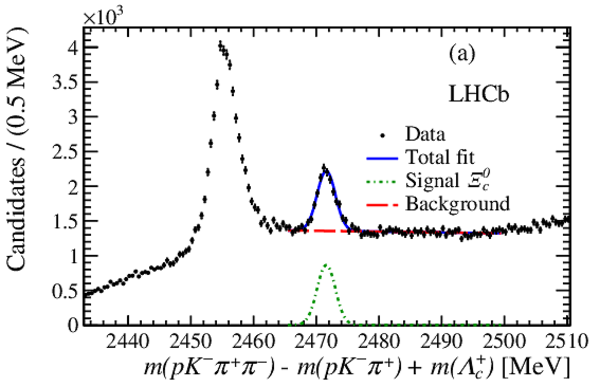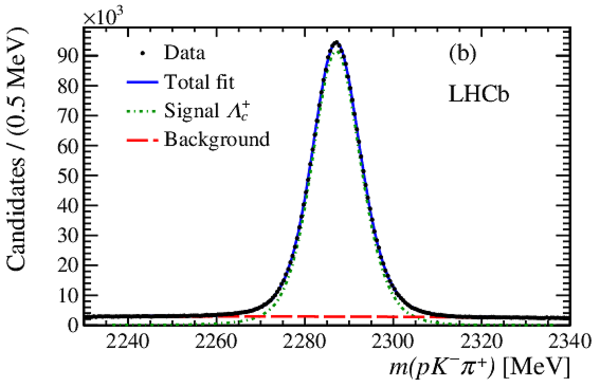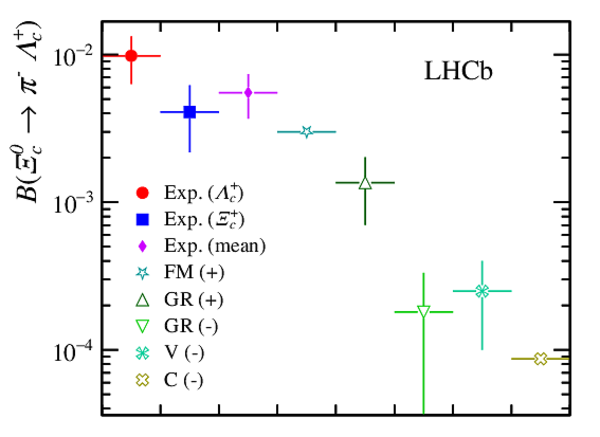First branching fraction measurement of the suppressed decay $\Xi_c^0\to \pi^-\Lambda_c^+$
[to restricted-access page]Information
LHCb-PAPER-2020-016
CERN-EP-2020-129
arXiv:2007.12096 [PDF]
(Submitted on 23 Jul 2020)
Phys. Rev. D102 (2020) 071101(R)
Inspire 1808540
Tools
Abstract
The $\Xi_c^0$ baryon is unstable and usually decays into charmless final states by the $c \to s u\overline{d}$ transition. It can, however, also disintegrate into a $\pi^-$ meson and a $\Lambda_c^+$ baryon via $s$ quark decay or via $cs\to d c$ weak scattering. The interplay between the latter two processes governs the size of the branching fraction ${\cal{B}}$$(\Xi_c^0\to \pi^-\Lambda_c^+)$, first measured here to be $(0.55\pm 0.02 \pm 0.18)$%, where the first uncertainty is statistical and second systematic. This result is compatible with the larger of the theoretical predictions that connect models of hyperon decays using partially conserved axial currents and SU(3) symmetry with those involving the heavy-quark expansion and heavy-quark symmetry. In addition, the branching fraction of the normalization channel, ${\cal{B}}(\Xi_c^+\to p K^- \pi^+) = (1.135 \pm 0.002 \pm 0.387)$% is measured.
Figures and captions
|
Decay diagrams for $\Xi ^0_ c \rightarrow \pi^-\Lambda_c^+$ transitions. (a) The SUUD amplitude, and (b) the WS amplitude. |
Xic0-diag.pdf [260 KiB] HiDef png [77 KiB] Thumbnail [63 KiB] *.C file |

|
|
Reconstructed invariant-mass distributions and signal fits of (a) $m(pK^-\pi^+\pi^-)$ showing a large $\Sigma_c^0$ signal with a smaller $\Xi_c^0$ signal, (b) $m(pK^-\pi^+)$ showing the $\Lambda ^+_ c $ signal, and (c) $m(pK^-\pi^+)$ showing the $\Xi_c^+$ signal. For (a) the signal shape is a Crystal Ball function [28] with a high-mass tail, and the background shape is linear. For (b) and (c) the signal shapes are double-sided Crystal Ball plus single Gaussian functions, while the background shapes are second-order polynomials. The data in (b) only use 1/10 of the available sample. |
dataXic0.pdf [34 KiB] HiDef png [218 KiB] Thumbnail [209 KiB] *.C file |

|
|
dataLc.pdf [33 KiB] HiDef png [215 KiB] Thumbnail [190 KiB] *.C file |

|
|
|
dataXicp.pdf [33 KiB] HiDef png [212 KiB] Thumbnail [184 KiB] *.C file |

|
|
|
Comparison of our two measurements of $\mathcal{B} \left(\Xi ^0_ c \rightarrow \pi ^- \Lambda ^+_ c \right)$, and their average, with the lower limit of Voloshin (V [5], the upper limit of Faller and Mannel [8] (FM), updated predictions of Gronau and Rosner [6] (GR), and Cheng et al. [9] (C). The (+ or $-$) indicates if positive or negative interference between the SUUD and WS amplitudes is assumed. |
compar[..].pdf [14 KiB] HiDef png [124 KiB] Thumbnail [105 KiB] *.C file |

|
|
Animated gif made out of all figures. |
PAPER-2020-016.gif Thumbnail |

|
Tables and captions
|
Systematic uncertainties in the branching fraction measurements. Ghost tracks refers to uncertainties from falsely reconstructed tracks. PID refers to particle identification efficiencies. Intermediate decays refers to the uncertainties caused by inexact modeling of the resonant structures in the charmed-baryon decays. The $b$-decay sources refer to charmed baryons originating from $b$-baryon decays included in our primarily prompt samples. Relative $\int\mathcal{L} $ refers to minor differences in the accumulated luminosities of the data samples for each of the three decays. The summed uncertainties are obtained by adding the individual components in quadrature. |
Table_1.pdf [80 KiB] HiDef png [118 KiB] Thumbnail [57 KiB] tex code |

|
Created on 20 April 2024.
